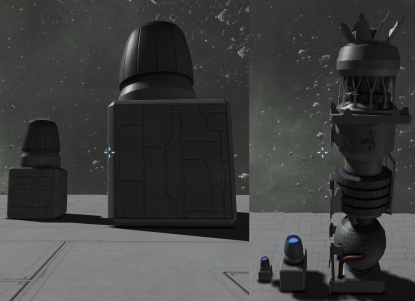 All my prior blog posts have been about Agile development and selling yourself to employers. So this entries’ subject may come as a bit of a surprise. Today I am going to enlighten my readers on a different form of development that occurs within the computer game software industry.
All my prior blog posts have been about Agile development and selling yourself to employers. So this entries’ subject may come as a bit of a surprise. Today I am going to enlighten my readers on a different form of development that occurs within the computer game software industry.
This form of development is known within the gaming community as “modding.” For those of you who are unfamiliar with the term, modding typically refers to user-created content (ranging anywhere from physics engine tweaks to visual texture redesigns) that is made post-release for commercial computer games.
That term “user-created content” can be found in a variety of software, Google Chrome for example gives community developers the ability to develop extensions for the browser that provide additional functionality. The idea with computer game modding is very similar, the developers ideally design the game with a modding API so that community developers, sometimes small teams but often individuals, can write a “mod” that tweaks some aspect of the game with the intent of making it better, fixing something the developers won’t fix, or just for the sake of humor. If we look at the modding community behind the vast multitude of mods for the computer game “The Elder Scrolls: Skyrim,” we can see that there are mods made for improving the combat system, fixing software bugs that the official development team never got around to fixing, and mods that add things that are just down right silly; such as replacing the appearance dragons commonly found throughout the game with children’s cartoon characters that fly around breathing fire onto the player.
Silliness aside, encouraging an active modding community has some major benefits for development studios that choose to employ it. For starters, the game will grow long past its development life span. This varies depending on how extensive the modding api is, if the modding api only allows access to visual textures then the modding community won’t have much to work with and it will fizzle out very quickly. However by granting the community nearly full-access to the game’s capabilities, the modding community can create new missions for the player, new stories and plot-lines, new dialogue, gameplay, sounds, graphics, scripted events, and a plethora of other possibilities that were probably excluded from the original game due to development budget constraints.

(Figure A) Left: Standard thruster options in Space Engineers. Right: User-made option alongside standard options. Screenshot credit: Sean Vail
Modders can even go one step further than small additions; in 1998 the Valve Software corporation released the computer game Half-Life. Half-Life’s game engine was easily moddable and the community eventually created such comprehensive mods that the result splintered off into a separate game, known as Counterstrike, and eventually was sold as a retail game itself (Sotamaa, 2003). This active modding community can also alleviate demand for new features from the developers. We can see an example of this in the title “Space Engineers” in which there used to be only two options for thrusters in the game for players to build spacecraft with, the modding community reacted quickly to this void and added a variety of new thruster options to the game, as can be seen in Figure A.
Developers stand to gain quite a lot by building game-engines capable of supporting these user-generated additions, and it ultimately leads to a far more pleasing experience for the user when the game they purchase is continuously improved upon by the community long after the developers have stopped supporting it.
Citations:
Pong [Image]. Retrieved November 2, 2014, from: http://bit.ly/12cBaCR
(Secondary)
Scacchi, W. (2010). Computer game mods, modders, modding, and the mod scene. First Monday, 15(5). doi:10.5210/fm.v15i5.2965
(Primary)
Sotamaa, O. (2003). Computer game modding, intermediality and participatory culture. New Media, 1-5.
Sean this may be the first blog I have read that left me wanting more, and I mean that in a good way. This topic is something I can definitely relate to, and while I have not partaken in modding a game myself or actually used a mod, I find the community that supports it to be absolutely brilliant. I hope as much knowledge of Computer Science deepens and I have more time available to do so, I can contribute my own modifications as well. We actually had an elective offering this semester at SJSU that was based upon modding Mine Craft, but I did not have the available time slot to take it unfortunately.
There are tons of SkyRim mods I am familiar with. If I recall, one devoted user actually expanded the game by 2/3 of the original size which is just incredible. For someone looking to break into the industry, this is for certain the way to do it. The biggest surprise I ran into while reading your article was that Counterstrike was originally started as a Half-Life mod! That is amazing and gives me so much respect for Valve for not interfering with the success of that game. I never got into Counterstrike, I was more of an Unreal Tournament fan, but Half-Life was a ton of fun to play! I still need to get around to Portal and Portal 2.
Great topic and a joy to read. If we have more freedom with our blog topics in the future I’ll definitely be keeping an eye out for what you come up with next.
LikeLike
This blog post was really interesting, especially finding out how counter strike originated. That surprised me knowing that such a successful game borrowed its roots from another game. I do agree how modding gives a new breath of life to an age-old game. Modding is not only beneficial for the gamers themselves, but also for the industry that created the game because with modding, the game has the potential to never get old. One example would be Grand Theft Auto: San Andreas. That game has so many unbelievable and funny mods that people still play that game to this day. I also can relate to the Skyrim mods as I have seen a handful of Youtube videos depicting these mods. I thought this was a really interesting read and good job on the post as a whole!
LikeLike
This is a very well written blog that covers a largely over looked section of game development. Modding can help keep a game alive and well many years after the original developers stop supporting it. This helps players to explore a curiosity by fixing or modifying what they want in a game to be more like what it was imagined to be. Overall the blog is well written and covers an interesting topic. The blog flowed really well. Well done!
LikeLike
Very spot on with the Half-Life example. I’ve been playing around with mods since the original Half Life, and the amount of patience a developer has when creating content as rich as mods is out of this world. User-Created content is at an all time high with games such as Minecraft, and tools such as the Source Engine. Overall, the Gaming Industry evolved with tools that help users create their own content. Even though content might take a while to create, it is the features that users create that help developers introduce these same features to a worldwide audience. Even though this is a topic unrelated to all blog posts beforehand, the quality that went through to create a post like this is outstanding.
LikeLike